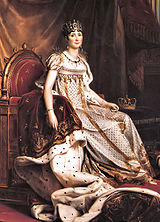
Waistline (clothing)
Encyclopedia

Clothing
Clothing refers to any covering for the human body that is worn. The wearing of clothing is exclusively a human characteristic and is a feature of nearly all human societies...
is often used to accentuate different features. The waistline is also important as a boundary at which shaping dart
Dart (sewing)
Darts are folds sewn into fabric to help provide a three-dimensional shape to a garment. They are frequently used in women's clothing to provide a fit that closely follows the shape of the wearer.Two kinds of darts are common in blouses for women:...
s (such as those over the bust and in the back) can be ended.
Types of waistlines
Similar to necklineNeckline
The neckline is the top edge of a garment that surrounds the neck, especially from the front view. Neckline also refers to the overall line between all the layers of clothing and the neck and shoulders of a person, ignoring the unseen undergarments....
s, waistlines may be grouped by their shape, depth, and location of the body.
- None: The princess seam style of dress needs no waistline at all, since it does its shaping without darts, by joining edges of different curvature. The resulting "princess seams" typically run vertically from the shoulder (or under the arm) over the bust point and down to the lower hem. This creates a long, slimming look, often seen in dresses with an "A-line" silhouette.
- Diagonal: An asymmetrical waistline that runs across the body diagonally. Usually the highest point is below the natural waistline.
- Drop waist: A low, horizontal waistline that usually falls near the level of the upper hips. Balances the upper and lower bodies, and adds to the visual impression of height by lengthening the torso.
- Empire: A high waistline that cuts horizontally across the body, just below the bust. This waistline gives a long, slender look and excellent fabric drape in the skirt and allows for short, inconspicuous shaping darts. This waistline was popular in Jane AustenJane AustenJane Austen was an English novelist whose works of romantic fiction, set among the landed gentry, earned her a place as one of the most widely read writers in English literature, her realism and biting social commentary cementing her historical importance among scholars and critics.Austen lived...
's time; see Empire silhouetteEmpire silhouetteAn Empire silhouette is created by a woman wearing a high-waisted dress, gathered near or just under the bust with a long, loose skirt, which skims the body. The outline is especially flattering to pear shapes wishing to disguise the stomach area or emphasise the bust. The shape of the dress also...
. - Raised: A horizontal waistline that falls significantly above (>1 in.) the natural waist.
- Natural: A horizontal waistline that falls at the natural waist and tends to make the wearer seem shorter by visually dividing the figure in half.
- V-shaped: A generally flattering waistline, especially for figures with notable curvature. Also known as the Basque waistline or the Antebellum waistline.
- U-shaped: A softer, less pronounced version of the Basque waistline.
- Inverted V-shaped: Starts high in the center and drops at the sides and can fall as high as the bustline (e.g., paired with a low V neckline to give a "bowtie" look), but usually found near the hips (e.g., extending Bolero curves in the bodice).
- Inverted U-shaped: A softer, less pronounced version of the inverted-V waistline, usually a gentle downwards curve.
Secure mechanisms
Waistlines can be secured with a variety of methods:- ButtonButtonIn modern clothing and fashion design, a button is a small fastener, most commonly made of plastic, but also frequently of seashell, which secures two pieces of fabric together. In archaeology, a button can be a significant artifact. In the applied arts and in craft, a button can be an example of...
- ClaspClaspClasp, clasper or CLASP may refer to:* Medal bar, an element in military decoration* Fastener, a hardware device that mechanically joins objects together* "Clasp", a track from Jethro Tull's album Broadsword and the Beast...
- DrawstringDrawstringA drawstring is a string, cord, or rope used to "draw" or tie closed an opening in fabric or other material...
- ElasticElastomerAn elastomer is a polymer with the property of viscoelasticity , generally having notably low Young's modulus and high yield strain compared with other materials. The term, which is derived from elastic polymer, is often used interchangeably with the term rubber, although the latter is preferred...
- KnotKnotA knot is a method of fastening or securing linear material such as rope by tying or interweaving. It may consist of a length of one or several segments of rope, string, webbing, twine, strap, or even chain interwoven such that the line can bind to itself or to some other object—the "load"...
- ZipperZipperA zipper is a commonly used device for temporarily joining two edges of fabric...

